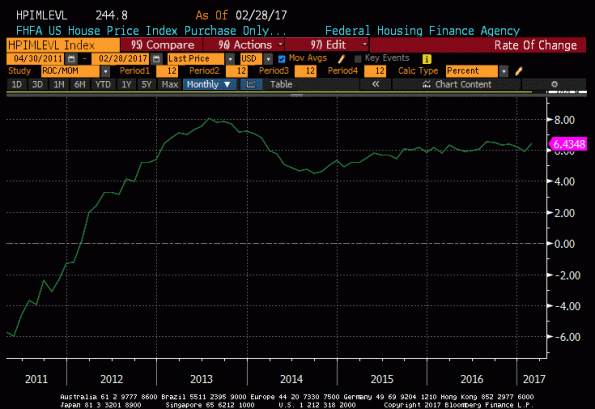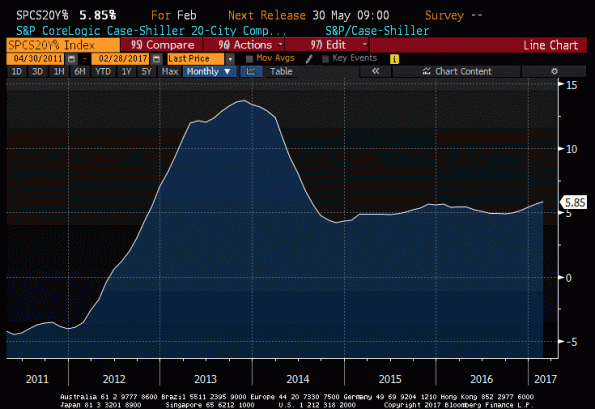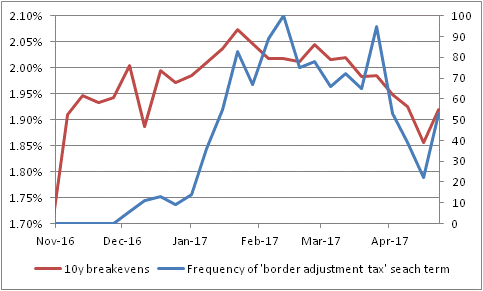Yesterday's news of the day – at least, from the standpoint of someone interested in inflation and inflation markets – was President Trump’s announcement of a new tariff on Canadian lumber. The new tariff, which is a response to Canada’s “alleged” subsidization of sales of lumber to the US (“alleged,” even though it is common knowledge that this occurs and has occurred for many years), ran from 3% to 24% on specific companies where the US had information on the precise subsidy they were receiving, and 20% on other Canadian lumber companies.
In related news, lumber is an important input to homebuilding. Several home price indicators were out yesterday: the FHA House Price Index for new purchases was up 6.43% y/y, the highest level in a while (see chart, source Bloomberg).

The Case-Shiller home price index, which is a better index than the FHA index, showed the same thing (see chart, source Bloomberg). The first bump in home price growth, in 2012 and 2013, was due to a rebound to the sharp drop in home prices during the credit crisis. But this latest turn higher cannot be due to the same factor, since home prices have nearly regained all the ground that they lost in 2007-2012.

Those price increases are in the prices of existing homes, of course, but I wanted to illustrate that, even without new increases in materials costs, housing costs were continuing to rise faster than incomes and faster than prices generally. But now, the price of new homes will also rise due to this tariff (unless the market is slack and so builders have to absorb the cost increase, which seems unlikely to happen). Thus, any ebbing in core inflation that we may have been expecting as home price inflation leveled off may be delayed somewhat longer.
But the tariff hike is symptomatic of a policy that provokes deeper concern among market participants. As I’ve pointed out previously, de-globalization (aka protectionism) is a significant threat to inflation not just in the United States, but around the world. While I am not worried that most of Trump’s proposals would result in a “reflationary trade” due to strong growth – I am not convinced we have solved the demographic and productivity challenges that keep growth from being strong by prior standards, and anyway growth doesn’t cause inflation – I am very concerned that arresting globalization will. This isn’t all Trump’s fault; he is also a symptom of a sense among workers around the world that globalization may have gone too far, and with no one around who can eloquently extol the virtues of free trade, tensions were likely to rise no matter who occupied the White House. But he is certainly accelerating the process.
Not only do inflation markets understand this, it is right now one of the most-significant things affecting levels in inflation markets. Consider the chart below, which compares 10-year breakeven inflation (the difference between 10-Year Treasuries and 10-year TIPS) to the frequency of “Border Adjustment Tax” as a search term in news stories on Google (NASDAQ:GOOGL).
The market clearly anticipated the Trumpflation issue, but as the concern about BAT (LON:BATS) declined so did breakevens. Until today, when 10-year breakevens jumped 5-6bps on the Canadian tariff story.
At roughly 2%, breakevens appear to be discounting an expectation that the Fed will fail to achieve its price inflation target of 2% on PCE (which would be about 2.25% on CPI), and also excluding the value of any “tail outcomes” from protectionist battles. When growth flags, I expect breakevens will as well – and they are of course not as cheap as they were last year (by some 60-70bps). But from a purely clinical perspective, it is still hard to see how TIPS can be perceived as terribly rich here, at least relative to nominal Treasury bonds.

